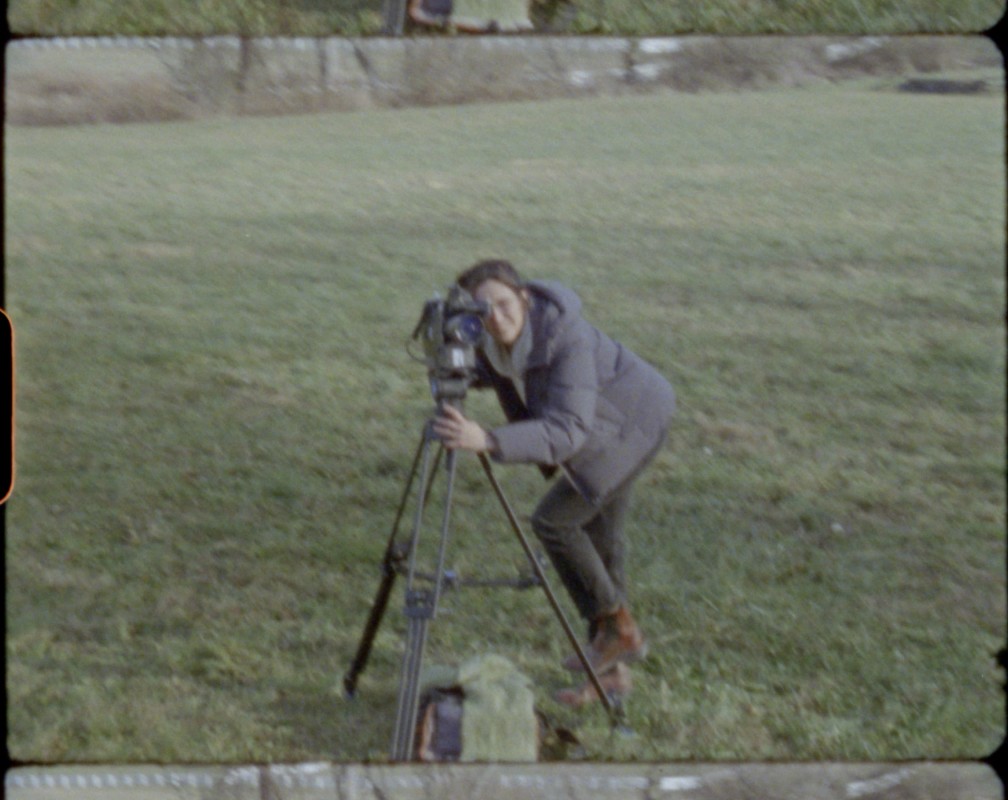Film and the body: Cinema professor explores the depth of experience through experimental work
Sofia Theodore-Pierce’s latest film, Exterior Turbulence, is now available through the streaming service Criterion

Exterior Turbulence is a hushed film, full of softly spoken and deeply personal words, coupled with evocative and shifting imagery.
The 11-minute stream-of-consciousness piece is also an attempt by filmmaker Sofia Theodore-Pierce to communicate what it’s like to live with epilepsy. But if you come away with a different message, that’s okay, too.
“All of my short films are fairly dense and layered. I’m as interested in hearing what people take away from them as I am in making them, so I spend a lot of time building them out to provide room for many possible takeaways,” said Theodore-Pierce, who joined Binghamton University in fall 2023 as an assistant professor of cinema.
Prior to that, she lived in New York City, Boston and the Pacific Northwest, and then spent five years living and teaching in Milwaukee, where she earned her MFA. She was drawn to Binghamton’s cinema department because of its history of personal work, and has designed and taught two classes — Nonfiction Poetics and Personal Cinema — inspired by her own creative process.
Currently, Exterior Turbulence is available via the distribution service Criterion, which features both classic and contemporary films. The company, which now runs a streaming service, is well-known among cinephiles. When Theodore-Pierce was an undergraduate, her friends collected and shared Criterion DVDs, and they would also rent box sets from the library. Today, she recommends Criterion Channel programming to her students.
Theodore-Pierce’s inroad came via Prismatic Ground, a New York-based film festival; the service streams a curated collection of films from each year’s festival for a limited run that lasts two years.
“This is a big deal for experimental filmmakers like me because it provides a much wider audience to films that otherwise are often only seen in festivals or classrooms,” she said.
The film recalls a year of stormy weather in fragments, with seizure dreams, horses and long-distance conversations in bed. Seizures are referenced in the film, but it also explores how our intimate relationships can sustain us through periods of darkness or uncertainty, she said.
The title comes from an excerpt from the Marguerite Duras film Baxter, Vera Baxter, which plays in the background of some scenes. When Theodore first watched that film, she was struck by a looping musical track that goes unacknowledged for a long time before a character addresses it with the words: “They call it ‘exterior turbulence.’”
“This is very similar to how I experience epileptic auras. It’s a cinematic move that really resonates with me, not just formally but in my body,” she said. “I wanted to use that as a framework for a film and pay direct homage to where the idea came from.”
Duras also talked about how filmmaking was a way to combat loneliness by giving her an excuse to be in the community. It’s a message that resonates with Theodore.
“Artmaking can be a very isolating activity; it requires being alone at times, but ultimately, it opens you up to forming deep bonds through working closely with people — asking for help and feedback,” she reflected.
A ‘measured mess’
Theodore-Pierce shot the footage that comprises the film over two years, during which she edited, wrote and collected sound. She admits that her creative process is chaotic, in that she operates in all stages of production at once; the result, however, is vibrant and akin to a diary in film.
“I like to call this approach my measured mess,” she said. “I would say all of my films in some way engage in what we might call diary film, but I complicate that quite a bit with fictional elements and my use of collage methodologies in the edit.”
The text in Exterior Turbulence combines excerpted texts from other writers, mixed with her own diaristic writing. The only way to tell which is which is italics, left to the audience to figure out; Theodore-Pierce enjoys blurring subjectivities in personal narrative, she said.
The film also uses audio recordings of her mother, including a love letter on cassette made for Theodore-Pierce’s father when they were first dating. Other times, the filmmaker’s friends speak the words.
“Sound and voice are a huge part of my practice. Sometimes we can speak for one another, and that’s a very particular type of intimacy and relating,” she reflected. “It’s also ethically complicated to blur identities that way, and it’s part of what I’m interested in highlighting in hybrid nonfiction work.”
The film also blurs images of Theodore-Pierce and a friend, cutting together clips of them wearing the same clothes in the same bed. This potential blurring of identity through intimacy among women is actually one of the keys to the film, she said.
For Theodore-Pierce, the act of creation harnesses the body; sometimes, she holds her breath during a difficult shot or sighs as the film runs out on the Bolex. In a sense, this explains the importance of sound to her work; sound passes through our bodies and activates them in a wholly different way, she said.
“It’s when I begin making sound pairings in the edit that the images come alive in a new way; they are transformed and take on meaning,” she said.
